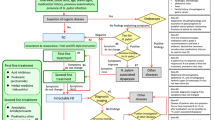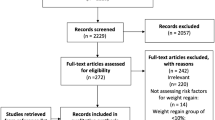Abstract
Background
Attention has recently focused on decreased quality of life (QOL) that occurs in postgastrectomy patients. We verified how gastric emptying function affected QOL.
Methods
Subjects were 72 consecutive patients after gastrectomy for cancer, including 25 after distal gastrectomy (DG), 18 after proximal gastrectomy (PG), 16 after pylorus-preserving gastrectomy (PpG), and 13 after total gastrectomy (TG). Using the 13C breath test method, 13CO2 levels in breath were measured over 2 h, and T max was determined. Questionnaires (Japanese versions of the Short-Form 36 [SF-36] and Gastrointestinal Symptom Rating Scale [GSRS]) were used to analyze QOL and correlations between questionnaire results and T max.
Results
Mean T max (min) for each procedure was 15.4 for DG, 21.1 for PG, 41.3 for PpG, and 10.4 for TG. T max differed between procedures, but not between survey periods. SF-36 was not correlated with T max, whereas GSRS showed a difference in diarrhea and total score between procedures, but not between survey periods. In addition, GSRS correlated with T max for abdominal pain, indigestion, and total score. The total scores showed a significant symptom aggregation in patients with T max less than 21 min.
Conclusions
Gastrointestinal symptoms in postgastrectomy patients were associated with the function of the remaining stomach. The 13C breath test is useful for objectively assessing such symptoms.



Similar content being viewed by others
References
Ghoos YF, Maes BD, Geypens BJ et al (1993) of gastric emptying rate of solids by means of a carbon-labeled octanoic acid breath test. Gastroenterology 104:1640–1647
Nakada K, Aoyama N, Nakagawa M et al (2002) Report of the workshop titled “The present and the future in gastric emptying study assessed by 13C breath test-with special reference to the standardization of the method” at the 44th Annual Meeting of the Japanese Smooth Muscle Society. J Smooth Muscle Res 6:J75–J91
Sanaka M, Nakada K (2010) Stable isotope breath tests for assessing gastric emptying: a comprehensive review. J Smooth Muscle Res 46:267–280
Ware JE Jr, Sherbourne CD (1992) The MOS 36-item short-form health survey (SF-36). I. Conceptual framework and item selection. Med Care 30:473–483
Fukuhara S, Bito S, Green J et al (1998) Translation, adaptation, and validation of the SF-36 health survey for use in Japan. J Clin Epidemiol 51:1037–1044
Fukuhara S, Ware JE Jr, Kosinski M et al (1998) Psychometric and clinical tests of validity of the Japanese SF-36 health survey. J Clin Epidemiol 51:1045–1053
Fukuhara S, Suzukamo Y (2004) Manual of SF-36 v2 Japanese version: Institute for Health Outcomes & Process Evaluation Research, Kyoto, Japan
Svedlund J, Sjodin I, Dotevall G (1988) GSRS—a clinical rating scale for gastrointestinal symptoms in patients with irritable bowel syndrome and peptic ulcer disease. Dig Dis Sci 33:129–134
Dimenas E, Glise H, Hallerback B et al (1995) Well-being and gastrointestinal symptoms among patients referred to endoscopy owing to suspected duodenal ulcer. Scand J Gastroenterol 30:1046–1052
Hongo M, Fukufara S, Green J (1999) QOL in digestive region. QOL evaluation by Japanese edition GSRS. Diagn Treat 87:731–736
Tyrvainen T, Sand J, Sintonen H et al (2008) Quality of life in the long-term survivors after total gastrectomy for gastric carcinoma. J Surg Oncol 97:121–124
Avery K, Hughes R, McNair A et al (2010) Health-related quality of life and survival in the 2 years after surgery for gastric cancer. Eur J Surg Oncol 36:148–154
Wu CW, Chiou JM, Ko FS et al (2008) Quality of life after curative gastrectomy for gastric cancer in a randomised controlled trial. Br J Cancer 98:54–59
Takeichi A, Oguma H, Sasagawa T et al (2003) Postoperative quality of life (QOL) for patients with gastric cancer who underwent distal gastrectomy reconstructed by Billroth-I (B-I). J Tokyo Wom Med Univ 73:450–456
Svedlund J, Sullivan M, Liedman B et al (1999) Long term consequences of gastrectomy for patient’s quality of life. The impact of reconstructive techniques. Am J Gastroenterol 94:438–445
Heading RC, Tothill P, McLoughlin GP et al (1976) Gastric emptying rate measurement in man. A double isotope scanning technique for simultaneous study of liquid and solid components of a meal. Gastroenterology 71:45–50
Hanyu N, Nakada K, Aoki T (1999) Measurement of gastric emptying by scintigraphic technique. Gastroenterology 28:220–227
Kawasaki N, Nakada K, Nakayoshi T et al (2006) The significance of T max by gastric emptying study using 13C-breath test, Comparison with direct method. Dig Absorpt 29:23–25
Author information
Authors and Affiliations
Corresponding author
Rights and permissions
About this article
Cite this article
Hayami, M., Seshimo, A., Miyake, K. et al. Effects of Emptying Function of Remaining Stomach on QOL in Postgastrectomy Patients. World J Surg 36, 373–378 (2012). https://doi.org/10.1007/s00268-011-1379-x
Published:
Issue Date:
DOI: https://doi.org/10.1007/s00268-011-1379-x




